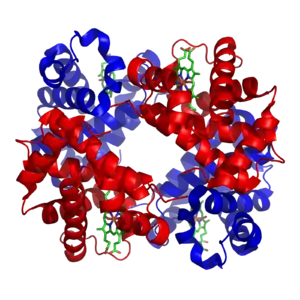Hemoglobinuria
| Hemoglobinuria | |
|---|---|
| Other names | Haemoglobinuria |
 | |
| Structure of hemoglobin | |
| Specialty | Urology, nephrology |
Hemoglobinuria is a condition in which the oxygen transport protein hemoglobin is found in abnormally high concentrations in the urine.[1] The condition is caused by excessive intravascular hemolysis, in which large numbers of red blood cells (RBCs) are destroyed, thereby releasing free hemoglobin into the plasma.[2] Excess hemoglobin is filtered by the kidneys, which excrete it into the urine, giving urine a purple color. Hemoglobinuria can lead to acute tubular necrosis which is an uncommon cause of a death of uni-traumatic patients recovering in the ICU.
Causes
- Acute glomerulonephritis
- Burns
- Renal cancer
- Malaria
- Paroxysmal nocturnal hemoglobinuria
- Microangiopathies, e.g. hemolytic-uremic syndrome (HUS), thrombotic thrombocytopenic purpura (TTP) leading to microangiopathic hemolytic anemia
- Transfusion reactions
- IgM autoimmune hemolytic anemia
- Glucose-6-phosphate dehydrogenase deficiency
- Pyelonephritis
- Sickle cell anemia
- Tuberculosis of the urinary tract
- March hemoglobinuria secondary to repetitive impacts on the body, usually the feet
- Athletic nephritis secondary to strenuous exercise
- Acute lead poisoning
Diagnosis
The diagnosis is often made based on the medical history, blood samples, and a urine sample. The absence of urine RBCs and RBC casts microscopically despite a positive dipstick test suggests hemoglobinuria or myoglobinuria. The medical term for RBCs in the urine is hematuria.
See also
References
- ↑ Deters, A.; Kulozik, A. E. (2003). "Hemoglobinuria". Practical Algorithms in Pediatric Hematology and Oncology: 20–21. doi:10.1159/000069582. ISBN 3-8055-7432-0. Retrieved 20 October 2019.
- ↑ Harper, James L (30 September 2020). "What causes hemoglobinuria?". www.medscape.com. Retrieved 5 April 2021.
External links